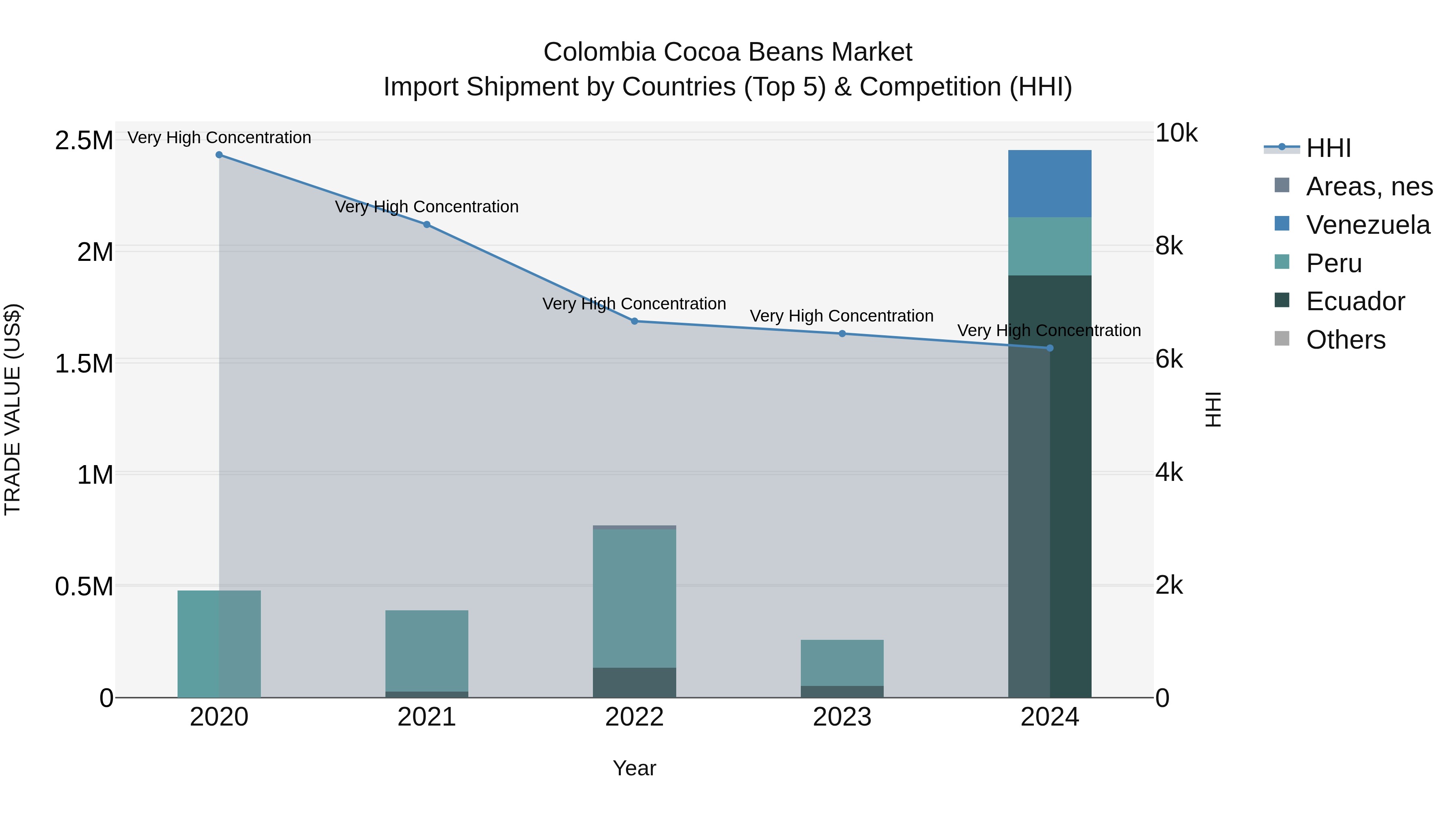Colombia Cocoa Beans Market (2025-2031) | Outlook, Trends, Share, Value, Revenue, Growth, Forecast, Companies, Size, Industry & Analysis
| Product Code: ETC015384 | Publication Date: Oct 2020 | Updated Date: Nov 2025 | Product Type: Report | |
| Publisher: 6Wresearch | Author: Ravi Bhandari | No. of Pages: 70 | No. of Figures: 35 | No. of Tables: 5 |
Colombia Cocoa Beans Market: Top 5 Importing Countries and Market Competition (HHI) Analysis
Colombia cocoa beans import shipments in 2024 saw significant growth, with top exporting countries being Ecuador, Venezuela, Peru, Areas, nes. The High Herfindahl-Hirschman Index (HHI) indicates a concentrated market, while the impressive Compound Annual Growth Rate (CAGR) of 50.29% from 2020 to 2024 underscores the expanding demand for cocoa beans in Colombia. The exceptional growth rate of 847.16% from 2023 to 2024 signals a rapid acceleration in import volumes, pointing towards a thriving market for cocoa beans in the country.

Colombia Cocoa Beans Market Overview
The cocoa beans market in Colombia holds a prominent position globally, owing to the country`s reputation for producing high-quality cocoa beans renowned for their rich flavor profile. Colombia unique geography and favorable climate create optimal conditions for cocoa cultivation, resulting in beans prized by chocolatiers and confectionery manufacturers worldwide. Additionally, Colombia commitment to sustainable farming practices further enhances the appeal of its cocoa beans in the global market.
Drivers of the market
Colombia cocoa beans market has been shaped by several factors, including the country`s reputation for producing high-quality cocoa beans, favorable climatic conditions, and growing demand for premium chocolate products globally. Colombia is renowned for its fine flavor cocoa beans, which are sought after by chocolate manufacturers and confectionery companies worldwide. The increasing awareness among consumers regarding the health benefits of dark chocolate and the rising demand for gourmet chocolate products have driven the growth of Colombia cocoa beans market. Additionally, government initiatives to support cocoa farmers and improve cocoa bean quality have further bolstered the market.
Challenges of the market
Despite its prominence in global cocoa production, the Colombia cocoa beans market encounters challenges that hinder its full potential. One significant obstacle is the prevalence of cocoa diseases and pests, such as witches` broom and frosty pod rot, which adversely affect yields and quality. This necessitates constant monitoring and investment in disease management strategies, increasing production costs for farmers. Moreover, limited access to credit and financing options constrains investment in modern farming practices and infrastructure, hindering productivity improvements. Additionally, fluctuations in international cocoa prices and demand volatility pose risks to the income stability of cocoa farmers, exacerbating poverty in cocoa-producing regions.
Government Policy of the market
Colombia cocoa beans market is characterized by its high-quality produce, sought after by chocolate manufacturers worldwide. Government policies aim to promote sustainable farming practices, including agroforestry techniques and organic certification, to enhance productivity and quality. Additionally, initiatives focus on improving access to markets and providing support to smallholder farmers to ensure inclusive growth in the cocoa sector.
Key Highlights of the Report:
- Colombia Cocoa Beans Market Outlook
- Market Size of Colombia Cocoa Beans Market, 2024
- Forecast of Colombia Cocoa Beans Market, 2031
- Historical Data and Forecast of Colombia Cocoa Beans Revenues & Volume for the Period 2021-2031
- Colombia Cocoa Beans Market Trend Evolution
- Colombia Cocoa Beans Market Drivers and Challenges
- Colombia Cocoa Beans Price Trends
- Colombia Cocoa Beans Porter's Five Forces
- Colombia Cocoa Beans Industry Life Cycle
- Historical Data and Forecast of Colombia Cocoa Beans Market Revenues & Volume By Product Type for the Period 2021-2031
- Historical Data and Forecast of Colombia Cocoa Beans Market Revenues & Volume By Butter for the Period 2021-2031
- Historical Data and Forecast of Colombia Cocoa Beans Market Revenues & Volume By Powder for the Period 2021-2031
- Historical Data and Forecast of Colombia Cocoa Beans Market Revenues & Volume By Liquor for the Period 2021-2031
- Historical Data and Forecast of Colombia Cocoa Beans Market Revenues & Volume By Application for the Period 2021-2031
- Historical Data and Forecast of Colombia Cocoa Beans Market Revenues & Volume By Confectionery for the Period 2021-2031
- Historical Data and Forecast of Colombia Cocoa Beans Market Revenues & Volume By Functional Food & Beverage for the Period 2021-2031
- Historical Data and Forecast of Colombia Cocoa Beans Market Revenues & Volume By Pharmaceuticals for the Period 2021-2031
- Historical Data and Forecast of Colombia Cocoa Beans Market Revenues & Volume By Cosmetics for the Period 2021-2031
- Historical Data and Forecast of Colombia Cocoa Beans Market Revenues & Volume By Distribution Channel for the Period 2021-2031
- Historical Data and Forecast of Colombia Cocoa Beans Market Revenues & Volume By Online for the Period 2021-2031
- Historical Data and Forecast of Colombia Cocoa Beans Market Revenues & Volume By Offline for the Period 2021-2031
- Colombia Cocoa Beans Import Export Trade Statistics
- Market Opportunity Assessment By Product Type
- Market Opportunity Assessment By Application
- Market Opportunity Assessment By Distribution Channel
- Colombia Cocoa Beans Top Companies Market Share
- Colombia Cocoa Beans Competitive Benchmarking By Technical and Operational Parameters
- Colombia Cocoa Beans Company Profiles
- Colombia Cocoa Beans Key Strategic Recommendations
Frequently Asked Questions About the Market Study (FAQs):
1 Executive Summary |
2 Introduction |
2.1 Key Highlights of the Report |
2.2 Report Description |
2.3 Market Scope & Segmentation |
2.4 Research Methodology |
2.5 Assumptions |
3 Colombia Cocoa Beans Market Overview |
3.1 Colombia Country Macro Economic Indicators |
3.2 Colombia Cocoa Beans Market Revenues & Volume, 2021 & 2031F |
3.3 Colombia Cocoa Beans Market - Industry Life Cycle |
3.4 Colombia Cocoa Beans Market - Porter's Five Forces |
3.5 Colombia Cocoa Beans Market Revenues & Volume Share, By Product Type, 2021 & 2031F |
3.6 Colombia Cocoa Beans Market Revenues & Volume Share, By Application, 2021 & 2031F |
3.7 Colombia Cocoa Beans Market Revenues & Volume Share, By Distribution Channel, 2021 & 2031F |
4 Colombia Cocoa Beans Market Dynamics |
4.1 Impact Analysis |
4.2 Market Drivers |
4.3 Market Restraints |
5 Colombia Cocoa Beans Market Trends |
6 Colombia Cocoa Beans Market, By Types |
6.1 Colombia Cocoa Beans Market, By Product Type |
6.1.1 Overview and Analysis |
6.1.2 Colombia Cocoa Beans Market Revenues & Volume, By Product Type, 2021-2031F |
6.1.3 Colombia Cocoa Beans Market Revenues & Volume, By Butter, 2021-2031F |
6.1.4 Colombia Cocoa Beans Market Revenues & Volume, By Powder, 2021-2031F |
6.1.5 Colombia Cocoa Beans Market Revenues & Volume, By Liquor, 2021-2031F |
6.2 Colombia Cocoa Beans Market, By Application |
6.2.1 Overview and Analysis |
6.2.2 Colombia Cocoa Beans Market Revenues & Volume, By Confectionery, 2021-2031F |
6.2.3 Colombia Cocoa Beans Market Revenues & Volume, By Functional Food & Beverage, 2021-2031F |
6.2.4 Colombia Cocoa Beans Market Revenues & Volume, By Pharmaceuticals, 2021-2031F |
6.2.5 Colombia Cocoa Beans Market Revenues & Volume, By Cosmetics, 2021-2031F |
6.3 Colombia Cocoa Beans Market, By Distribution Channel |
6.3.1 Overview and Analysis |
6.3.2 Colombia Cocoa Beans Market Revenues & Volume, By Online, 2021-2031F |
6.3.3 Colombia Cocoa Beans Market Revenues & Volume, By Offline, 2021-2031F |
7 Colombia Cocoa Beans Market Import-Export Trade Statistics |
7.1 Colombia Cocoa Beans Market Export to Major Countries |
7.2 Colombia Cocoa Beans Market Imports from Major Countries |
8 Colombia Cocoa Beans Market Key Performance Indicators |
9 Colombia Cocoa Beans Market - Opportunity Assessment |
9.1 Colombia Cocoa Beans Market Opportunity Assessment, By Product Type, 2021 & 2031F |
9.2 Colombia Cocoa Beans Market Opportunity Assessment, By Application, 2021 & 2031F |
9.3 Colombia Cocoa Beans Market Opportunity Assessment, By Distribution Channel, 2021 & 2031F |
10 Colombia Cocoa Beans Market - Competitive Landscape |
10.1 Colombia Cocoa Beans Market Revenue Share, By Companies, 2024 |
10.2 Colombia Cocoa Beans Market Competitive Benchmarking, By Operating and Technical Parameters |
11 Company Profiles |
12 Recommendations |
13 Disclaimer |
- Single User License$ 1,995
- Department License$ 2,400
- Site License$ 3,120
- Global License$ 3,795
Search
Thought Leadership and Analyst Meet
Our Clients
Related Reports
- Canada Oil and Gas Market (2026-2032) | Share, Segmentation, Value, Industry, Trends, Forecast, Analysis, Size & Revenue, Growth, Competitive Landscape, Outlook, Companies
- Germany Breakfast Food Market (2026-2032) | Industry, Share, Growth, Size, Companies, Value, Analysis, Revenue, Trends, Forecast & Outlook
- Australia Briquette Market (2025-2031) | Growth, Size, Revenue, Forecast, Analysis, Trends, Value, Share, Industry & Companies
- Vietnam System Integrator Market (2025-2031) | Size, Companies, Analysis, Industry, Value, Forecast, Growth, Trends, Revenue & Share
- ASEAN and Thailand Brain Health Supplements Market (2025-2031) | Strategy, Consumer Insights, Analysis, Investment Trends, Opportunities, Growth, Size, Share, Industry, Revenue, Segments, Value, Segmentation, Supply, Forecast, Restraints, Outlook, Competition, Drivers, Trends, Demand, Pricing Analysis, Competitive, Strategic Insights, Companies, Challenges
- ASEAN Bearings Market (2025-2031) | Strategy, Consumer Insights, Analysis, Investment Trends, Opportunities, Growth, Size, Share, Industry, Revenue, Segments, Value, Segmentation, Supply, Forecast, Restraints, Outlook, Competition, Drivers, Trends, Demand, Pricing Analysis, Competitive, Strategic Insights, Companies, Challenges
- Europe Flooring Market (2025-2031) | Outlook, Share, Industry, Trends, Forecast, Companies, Revenue, Size, Analysis, Growth & Value
- Saudi Arabia Manlift Market (2025-2031) | Outlook, Size, Growth, Trends, Companies, Industry, Revenue, Value, Share, Forecast & Analysis
- Uganda Excavator, Crane, and Wheel Loaders Market (2025-2031) | Strategy, Consumer Insights, Analysis, Investment Trends, Opportunities, Growth, Size, Share, Industry, Revenue, Segments, Value, Segmentation, Supply, Forecast, Restraints, Outlook, Competition, Drivers, Trends, Demand, Pricing Analysis, Competitive, Strategic Insights, Companies, Challenges
- Rwanda Excavator, Crane, and Wheel Loaders Market (2025-2031) | Strategy, Consumer Insights, Analysis, Investment Trends, Opportunities, Growth, Size, Share, Industry, Revenue, Segments, Value, Segmentation, Supply, Forecast, Restraints, Outlook, Competition, Drivers, Trends, Demand, Pricing Analysis, Competitive, Strategic Insights, Companies, Challenges
Industry Events and Analyst Meet
Whitepaper
- Middle East & Africa Commercial Security Market Click here to view more.
- Middle East & Africa Fire Safety Systems & Equipment Market Click here to view more.
- GCC Drone Market Click here to view more.
- Middle East Lighting Fixture Market Click here to view more.
- GCC Physical & Perimeter Security Market Click here to view more.
6WResearch In News
- Doha a strategic location for EV manufacturing hub: IPA Qatar
- Demand for luxury TVs surging in the GCC, says Samsung
- Empowering Growth: The Thriving Journey of Bangladesh’s Cable Industry
- Demand for luxury TVs surging in the GCC, says Samsung
- Video call with a traditional healer? Once unthinkable, it’s now common in South Africa
- Intelligent Buildings To Smooth GCC’s Path To Net Zero


















